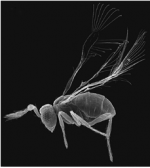
People who make toys, dollhouses, or other miniatures know that certain laws of physics apply that make miniaturization difficult. Certain laws of biology apply, too, but the fairy wasp seems to do an end-run around some of those rules. How else could an insect exist that is smaller than many single-celled creatures? Some are revealed by Alexey Polilov from Lomonosov Moscow State University, who has studied these tiny wasps for years.
Polilov found that M.mymaripenne has one of the smallest nervous systems of any insect, consisting of just 7,400 neurons. For comparison, the common housefly has 340,000 and the honeybee has 850,000. And yet, with a hundred times fewer neurons, the fairy wasp can fly, search for food, and find the right places to lay its eggs.
On top of that Polilov found that over 95 per cent of the wasps’s neurons don’t have a nucleus. The nucleus is the command centre of a cell, the structure that sits in the middle and hoards a precious cache of DNA. Without it, the neurons shouldn’t be able to replenish their vital supply of proteins. They shouldn’t work. Until now, intact neurons without a nucleus have never been described in the wild.
And yet, the fairy wasp has thousands of them. As it changes from a larva into an adult, it destroys the majority or its neural nuclei until just a few hundred are left. The rest burst apart, saving space inside the adult’s crowded head. But the wasp doesn’t seem to suffer for this loss. As an adult, it lives for around five days, which is actually longer than many other bigger wasps. As Zen Faulkes writes, “It’s possible that the adult life span is short enough that the nucleus can make all the proteins the neuron needs to function for five days during the pupal stage.”
There are other tricks tiny insects use to maintain life in miniature, which you can read at
Not Exactly Rocket Science.
 People who make toys, dollhouses, or other miniatures know that certain laws of physics apply that make miniaturization difficult. Certain laws of biology apply, too, but the fairy wasp seems to do an end-run around some of those rules. How else could an insect exist that is smaller than many single-celled creatures? Some are revealed by Alexey Polilov from Lomonosov Moscow State University, who has studied these tiny wasps for years.
People who make toys, dollhouses, or other miniatures know that certain laws of physics apply that make miniaturization difficult. Certain laws of biology apply, too, but the fairy wasp seems to do an end-run around some of those rules. How else could an insect exist that is smaller than many single-celled creatures? Some are revealed by Alexey Polilov from Lomonosov Moscow State University, who has studied these tiny wasps for years.
No comments:
Post a Comment